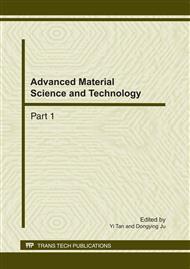p.1155
p.1159
p.1163
p.1167
p.1171
p.1175
p.1179
p.1185
p.1189
Three Layers Weaved once Structure Design and Performance Testing for Fabric Keyboard Switch
Abstract:
Flexible fabric keyboard is a field of smart textile. It can overcome traditional horniness keyboard can’t be foldable and washing. In this laboratory study there is Three Layers Weaved Once structure designed which consists of three kinds of orifice dimension, for example 4 wefts, 8 wefts and 12 wefts. At the same time three kinds of conductive filaments number combined are planed for each orifice dimension. There are 1, 4 and 8 roots of filaments combined together so that contact areas of the conductive material are changed. Then the immediate regain, connection pressure and connection ratio are tested and analyzed for every kind of fabric keyboard switch. It is concluded that 4 wefts orifice dimension and 4 roots of filaments combined is a better project. These findings may assist in recommendations regarding the further development of flexible fabric keyboard. The fabric keyboard switch forms the foundation for many smart textile applications.
Info:
Periodical:
Pages:
1171-1174
Citation:
Online since:
February 2011
Authors:
Price:
Сopyright:
© 2011 Trans Tech Publications Ltd. All Rights Reserved
Share:
Citation:


